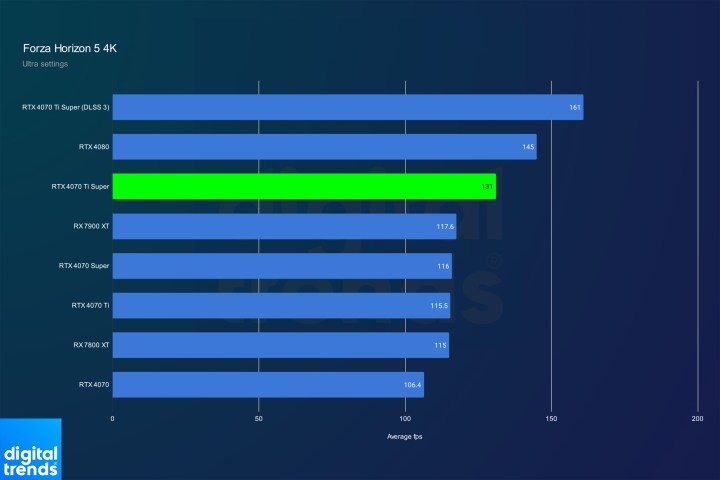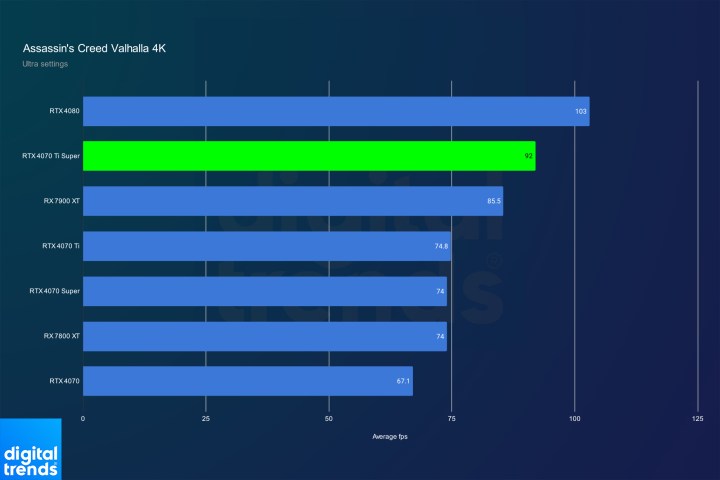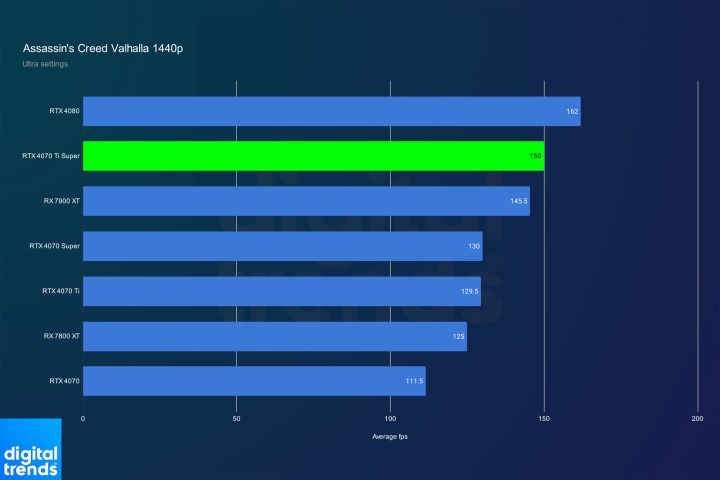Nvidia RTX 4070

Nvidia RTX 4070 Ti Super specs

The RTX 4070 Ti Super is an updated version of the RTX 4070 Ti, of course, but the changes under the hood are more significant than you might expect. On the surface, you’re getting a 10% bump to core count, which doesn’t sound as significant as what we saw with the RTX 4070 Super. And it’s not, but the RTX 4070 Ti Super has tricks of its own.
| RTX 4070 Ti Super | RTX 4070 Ti | |
| GPU | AD103 | AD104 |
| Interface | PCIe 4.0 x16 | PCIe 4.0 x16 |
| CUDA cores | 8,448 | 7,680 |
| Boost clock | 2.61GHz | 2.61GHz |
| Memory | 16GB GDDR6X | 12GB GDDR6X |
| Memory speed | 21 Gbps | 21 Gbps |
| Memory bus | 256-bit | 192-bit |
| TDP | 285W | 285W |
It’s based on the AD103 GPU, which is the GPU we see inside the RTX 4080 and the upcoming RTX 4080 Super. It also comes with the same memory interface as the RTX 4080, packing in 16GB GDDR6X over a 256-bit bus.
This is less of a beefed-up RTX 4070 Ti and more of a cut-down RTX 4080. It’s a full GPU move, fit with a bumped memory interface. It’s still a clear step below the RTX 4080, however, which is where the RTX 4070 Ti Super runs into some awkward positioning. It has 13% fewer cores than the RTX 4080, and nearly 18% less than the upcoming Super refresh.
Synthetic performance

Let’s start with an overview of where the RTX 4070 Ti Super should land among the competition. According to 3DMark Time Spy, the RTX 4070 Ti Super is only around 6% faster than the base model. That’s not an impressive uplift, but Nvidia isn’t charging any more for this Super model. Faster is better in this case, no matter how minor that improvement may be.
The more interesting comparisons are to the RTX 4080 and RX 7900 XT. Despite the GPU change, the RTX 4080 is around 12% faster. AMD’s RX 7900 XT, which is available for the same price as the RTX 4070 Ti Super and often on sale for less, ends up faster, too, though by a smaller 5%.

Time Spy is aging, however, and a more modern workload shows the cards stack in a different way. In 3DMark Port Royal, a ray tracing benchmark, the RTX 4070 Ti Super takes a backseat only to the RTX 4080 and RTX 4090. It’s around 10% faster than the base model and a solid 13% ahead of the RX 7900 XT.
4K gaming

We need to take a look at real games. Above, you can see the average performance of the RTX 4070 Ti Super, including every game I tested. That includes games with ray tracing. The RTX 4070 Ti Super scales higher than the synthetics would suggest, leading the base model by around 11%. However, the RX 7900 XT proves stiff competition again, essentially matching the RTX 4070 Ti Super.

There are some games where the RTX 4070 Ti Super doesn’t hit the mark. The Last of Us Part One is a great example, where the GPU struggles to maintain 60 frames per second (fps) at 4K. Make no mistake, at $800, the RTX 4070 Ti Super is a 4K GPU. It should be able to hit that mark like the RX 7900 XT and RTX 4080 can.


In titles like Cyberpunk 2077, the RTX 4070 Ti Super also struggles to hit 60 fps, though this is one of the most demanding titles you can run at this resolution. The key factor here is that it’s beaten by both the RX 7900 XT and RTX 4080. The card also takes a backseat in Returnal, offering just a 6% jump over the base model.


Those are, thankfully, the worst showcases of the RTX 4070 Ti Super. In Horizon Zero Dawn, the card leads the RX 7900 XT by 8% and provides an 18% uplift over the base model. Similarly, in Red Dead Redemption 2, it’s 7% ahead of the RX 7900 XT and 17% ahead of the base model.


Assassin’s Creed Valhalla and Forza Horizon 5 tell a similar story. The latter is an interesting example of what this Super refresh does for the RTX 4070 Ti. You can see a wall of GPUs stacked up around 115 fps, and the RTX 4070 Ti Super is doing something — probably the memory interface and how it interacts with this architecture — to break through that.
Overall, the improvements aren’t bad. There’s some tough competition from AMD’s RX 7900 XT, but the RTX 4070 Ti Super wins more often than it loses. Even so, this is an awkward resolution for this GPU. It can’t quite hit that fated 60 fps mark in every game, while the RTX 4080 can hit it with room to spare. Considering the upcoming RTX 4080 Super is only $200 more expensive than the RTX 4070 Ti Super, I have a hard time thinking this graphics card will make more sense over the RTX 4080 Super in builds targeting high-end gaming.
1440p gaming

Although you expect exceptional 4K performance from an $800 GPU, it’s not unreasonable to use one at 1440p. Stepping down the resolution, the RTX 4070 Ti Super maintains a solid lead over the base model, but the gap is tighter. It’s around 10% ahead of the base model. Thankfully, the RTX 4070 Ti Super outpaces the RX 7900 XT at this resolution, coming in a modest 3% ahead.


Once again, however, the RTX 4070 Ti Super doesn’t shine in every game. In Returnal and The Last of Us Part One, you can see the GPU take a clear backseat to the RX 7900 XT. Returnal shows some poor gains over the base RTX 4070 Ti, but thankfully, that doesn’t translate into The Last of Us Part One. In that game, the RTX 4070 Ti Super enjoys a 15% jump over the base model.


As we saw at 4K, there are other titles where the RTX 4070 Ti Super shows a more commanding lead. In Forza Horizon 5, the updated model once again breaks through a wall of performance, this time getting close to the RTX 4080. Horizon Zero Dawn shows a big jump, too, showcasing the poor value of the original RTX 4070 Ti.


Red Dead Redemption 2 and Assassin’s Creed Valhalla both show off that dynamic. In both of these games, the new RTX 4070 Super gets close and sometimes exceeds the original RTX 4070 Ti. This Super refresh not only puts Nvidia back in the lead but also helps Nvidia compete with the falling prices on the RX 7900 XT.
At 1440p, the RTX 4070 Ti Super looks a lot more impressive. It’s not struggling to hit a playable frame rate at this resolution, so the comparison to the RX 7900 XT and the gains over the base model hit a lot harder. It’s really at 4K where the card misses out, losing too much ground to the RTX 4080.
1080p gaming

You shouldn’t spend $800 on a GPU to game at 1080p. You’re better off with a card like the RTX 4060 or RX 7600, but I still ran some tests at this resolution to see how the RTX 4070 Ti performs. As expected, every card that I tested gets a bit closer together as the CPU becomes a more significant factor in performance.
Down at this resolution, the Super model is just 8% ahead of the RTX 4070 Ti. The gap between the RX 7900 XT and RTX 4070 Ti Super grows as well, with Nvidia’s card coming out about 5% ahead. It’s interesting to look at these numbers, but they don’t matter much in practice, considering how expensive the RTX 4070 Ti Super is.
Ray tracing and DLSS 3.5
Although the RTX 4070 Ti Super dukes it out with the RX 7900 XT in rasterized games, Nvidia has a dominating lead in ray tracing. That holds true here, but the more impressive showcase for the RTX 4070 Ti Super is Nvidia’s DLSS 3.5.



In Cyberpunk 2077 at 4K, the RTX 4070 Ti Super can’t hope to hold a playable frame rate. Sure, it beats the RX 7900 XT handily, but you don’t want to play this game at 25 fps. Flip the switch for DLSS 3.5, however, and you’re getting above 90 fps with maxed-out ray tracing settings.



It’s a good thing the RTX 4070 Ti Super has DLSS 3.5, as well. It doesn’t look nearly as impressive in less demanding ray tracing workloads. In Resident Evil 4, for example, the RTX 4070 Ti Super still loses out to the RX 7900 XT.



In Returnal, the RTX 4070 Ti Super is back on top, but only by a narrow margin. This title also shows some poor scaling from the base model to the Super version, with the RTX 4070 Ti Super only adding a few frames across resolutions.
Should you buy the RTX 4070 Ti Super?

The RTX 4070 Ti Super does exactly what Nvidia promised. It’s about 10% faster for the same price, and it’s hard to argue with a bit of extra performance. In addition, the updated memory interface pushes through some barriers that the original RTX 4070 Ti Super wasn’t able to clear, showcased by games like Forza Horizon 5.
Even with a solid performance uplift, the RTX 4070 Ti Super doesn’t solve the crux of the issue with the original GPU. It’s more powerful now, but not at that premium level of 4K gaming that you’d expect from an $800 graphics card. That’s even more true now, with the RX 7900 XT making the rounds for sometimes as little as $710 while offering similar performance.
However, the biggest problem for the RTX 4070 Ti Super is the RTX 4080 Super. That GPU launches at $1,000, and it’s sure to have a commanding lead over the RTX 4070 Ti Super at 4K. With both GPUs clearly targeting a segment of high-end, 4K gamers, the RTX 4080 Super seems like the obvious option for most people.
Overall, the RTX 4070 Ti isn’t a bad GPU. Just a little awkward.

